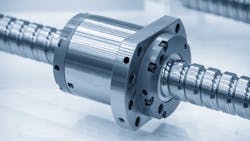The Basics of the Three Speeds of Ball Screws
This article was updated May 30, 2023. It was originally published March 20, 2017.
Speed is an important characteristic in ball screws, as it is for most motion control devices. But ball screws have three kinds of speed associated with them: critical speed, maximum speed and driving speed. Here’s a quick look at all three.
Critical Speed
Critical speed, nk, is the lowest rotational speed at which the ball-screw shaft is in resonance. In applications with rotating shafts, it limits the screw’s rpm. Variables that influence critical speed include the shaft diameter, unsupported length and the support bearings.
Similar to buckling, critical speed depends on how the support bearings are laid out. Fixed support bearings are assumed to resist angular deflection of the shaft, while simple support bearings do not. A bearing assembly of two simple bearings with a spacer, however, qualifies as a “fixed” bearing for these purposes.
For long screws, use the following equation. Make sure to select the proper factor for the bearing configuration used in it for the critical speed:
nk = k × dN × 1/(ls)2 × 107/min
where dN is the screw’s nominal diameter (mm), ls is the screw’s unsupported length (mm), and k is the support-bearing factor.
If the screw turns faster than its critical speed, it can create noise and do damage. Some engineers recommend operating balls screw at less than 80% of its critical speed.
Maximum Speed
The maximum speed is limited by inertial forces on the rolling balls, and it depends on the ball-nut’s return mechanism and ball size. In general, ball screws with small balls have somewhat lower speed limits than screws with larger balls. Steinmeyer ball screw speeds range from 4,500 rpm for 3-mm balls to about 1,050 rpm for 125-mm balls.
Driving Speed
The driving speed (DN) is a simplified way of determining the ball screw’s top rotational speed. It is simply the product of nominal diameter of the ball screw (in mm) times the maximum allowable speed (in rpm). Keep in mind that for extremely small or large screws, this will not return valid numbers.
DN lets engineers easily compare different ball screw designs. The higher the DN, the more sophisticated the ball return. DN values also correlate to ball velocity. DN is calculated by:
DN = nmax × dN
where nmax is the maximum speed (rpm) and dN is the nominal diameter (mm).
Most ball screw have maximum DN values between 60,000 and 120,000, and in some cases even higher.
RELATED
Calculating the Life of Ball and Roller Screw Actuators
Ball-Screw Design: The Advantages of Internal Ball Returns
What’s the Difference Between Roller and Ball Screws?
Bruce Gertz was executive vice president at Steinmeyer Inc. when this article was originally published.
